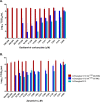Resistance to neuraminidase inhibitors conferred by an R292K mutation in a human influenza virus H7N9 isolate can be masked by a mixed R/K viral population
- PMID: 23860768
- PMCID: PMC3735122
- DOI: 10.1128/mBio.00396-13
Resistance to neuraminidase inhibitors conferred by an R292K mutation in a human influenza virus H7N9 isolate can be masked by a mixed R/K viral population
Abstract
We characterized the A/Shanghai/1/2013 virus isolated from the first confirmed human case of A/H7N9 disease in China. The A/Shanghai/1/2013 isolate contained a mixed population of R (65%; 15/23 clones) and K (35%; 8/23 clones) at neuraminidase (NA) residue 292, as determined by clonal sequencing. A/Shanghai/1/2013 with mixed R/K at residue 292 exhibited a phenotype that is sensitive to zanamivir and oseltamivir carboxylate by the enzyme-based NA inhibition assay. The plaque-purified A/Shanghai/1/2013 with dominant K292 (94%; 15/16 clones) showed sensitivity to zanamivir that had decreased by >30-fold and to oseltamivir carboxylate that had decreased by >100-fold compared to its plaque-purified wild-type counterpart possessing dominant R292 (93%, 14/15 clones). In Madin-Darby canine kidney (MDCK) cells, the plaque-purified A/Shanghai/1/2013-NAK292 virus exhibited no reduction in viral titer under conditions of increasing concentrations of oseltamivir carboxylate (range, 0 to 1,000 µM) whereas the replication of the plaque-purified A/Shanghai/1/2013-NAR292 and the A/Shanghai/2/2013 viruses was completely inhibited at 250 µM and 31.25 µM of oseltamivir carboxylate, respectively. Although the plaque-purified A/Shanghai/1/2013-NAK292 virus exhibited lower NA enzyme activity and a higher Km for 2'-(4-methylumbelliferryl)-α-d-N-acetylneuraminic acid than the wild-type A/Shanghai/1/2013-NAR292 virus, the A/Shanghai/1/2013-NAK292 virus formed large plaques and replicated efficiently in vitro. Our results confirmed that the NA R292K mutation confers resistance to oseltamivir, peramivir, and zanamivir in the novel human H7N9 viruses. Importantly, detection of the resistance phenotype may be masked in the clinical samples containing a mixed population of R/K at NA residue 292 in the enzyme-based NA inhibition assay.
Importance: The neuraminidase (NA) inhibitors oseltamivir and zanamivir are currently the front-line therapeutic options against the novel H7N9 influenza viruses, which possess an S31N mutation that confers resistance to the M2 ion channel blockers. It is therefore important to evaluate the sensitivity of the clinical isolates to NA inhibitors and to monitor for the emergence of resistant variants. We characterized the A/Shanghai/1/2013 (H7N9) isolate which contained a mixed population of R/K at NA residue 292. While the clinical isolate exhibited a phenotype of sensitivity to NA inhibitors using the enzyme-based NA inhibition assay, the plaque-purified A/Shanghai/1/2013 virus with dominant K292 was resistant to zanamivir, peramivir, and oseltamivir. Resistance to NA inhibitors conferred by the R292K mutation in a human influenza virus H7N9 isolate can be masked by a mixed R/K viral population, and this should be taken into consideration while monitoring antiviral resistance in patients with H7N9 infection.
Figures





References
-
- Chen Y, Liang W, Yang S, Wu N, Gao H, Sheng J, Yao H, Wo J, Fang Q, Cui D, Li Y, Yao X, Zhang Y, Wu H, Zheng S, Diao H, Xia S, Chan KH, Tsoi HW, Teng JL, Song W, Wang P, Lau SY, Zheng M, Chan JF, To KK, Chen H, Li L, Yuen KY. 2013. Human infections with the emerging avian influenza A H7N9 virus from wet market poultry: clinical analysis and characterisation of viral genome. Lancet 381:1916–1925 - PMC - PubMed
-
- Gao R, Cao B, Hu Y, Feng Z, Wang D, Hu W, Chen J, Jie Z, Qiu H, Xu K, Xu X, Lu H, Zhu W, Gao Z, Xiang N, Shen Y, He Z, Gu Y, Zhang Z, Yang Y, Zhao X, Zhou L, Li X, Zou S, Zhang Y, Yang L, Guo J, Dong J, Li Q, Dong L, Zhu Y, Bai T, Wang S, Hao P, Yang W, Han J, Yu H, Li D, Gao GF, Wu G, Wang Y, Yuan Z, Shu Y, Yuan Z, Shu Y. 2013. Human infection with a novel avian-origin influenza A (H7N9) virus. N. Engl. J. Med. 368:1888–1897 - PubMed
-
- Li Q, Zhou L, Zhou M, Chen Z, Li F, Wu H, Xiang N, Chen E, Tang F, Wang D, Meng L, Hong Z, Tu W, Cao Y, Li L, Ding F, Liu B, Wang M, Xie R, Gao R, Li X, Bai T, Zou S, He J, Hu J, Xu Y, Chai C, Wang S, Gao Y, Jin L, Zhang Y, Luo H, Yu H, Gao L, Pang X, Liu G, Shu Y, Yang W, Uyeki TM, Wang Y, Wu F, Feng Z. 2013. Preliminary report: epidemiology of the avian influenza A (H7N9) outbreak in China. N. Engl. J. Med. 10.1056/NEJMoa1304617 - DOI - PubMed
-
- Han J, Jin M, Zhang P, Liu J, Wang L, Wen D, Wu X, Liu G, Zou Y, Lv X, Dong X, Shao B, Gu S, Zhou D, Leng Q, Zhang C, Lan K. 2013. Epidemiological link between exposure to poultry and all influenza A(H7N9) confirmed cases in Huzhou city, China, March to 2013. Euro Surveill. 18:20481. - PubMed
Publication types
MeSH terms
Substances
Grants and funding
LinkOut - more resources
Full Text Sources
Other Literature Sources
Medical
